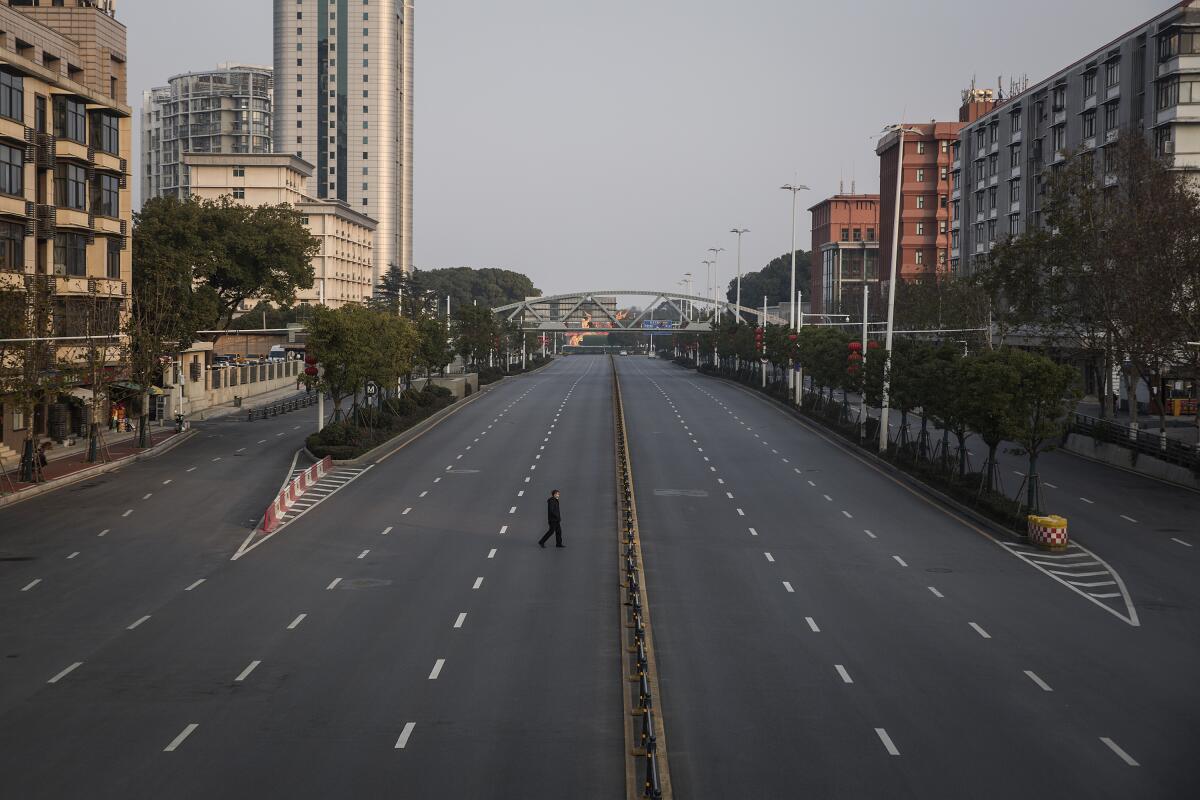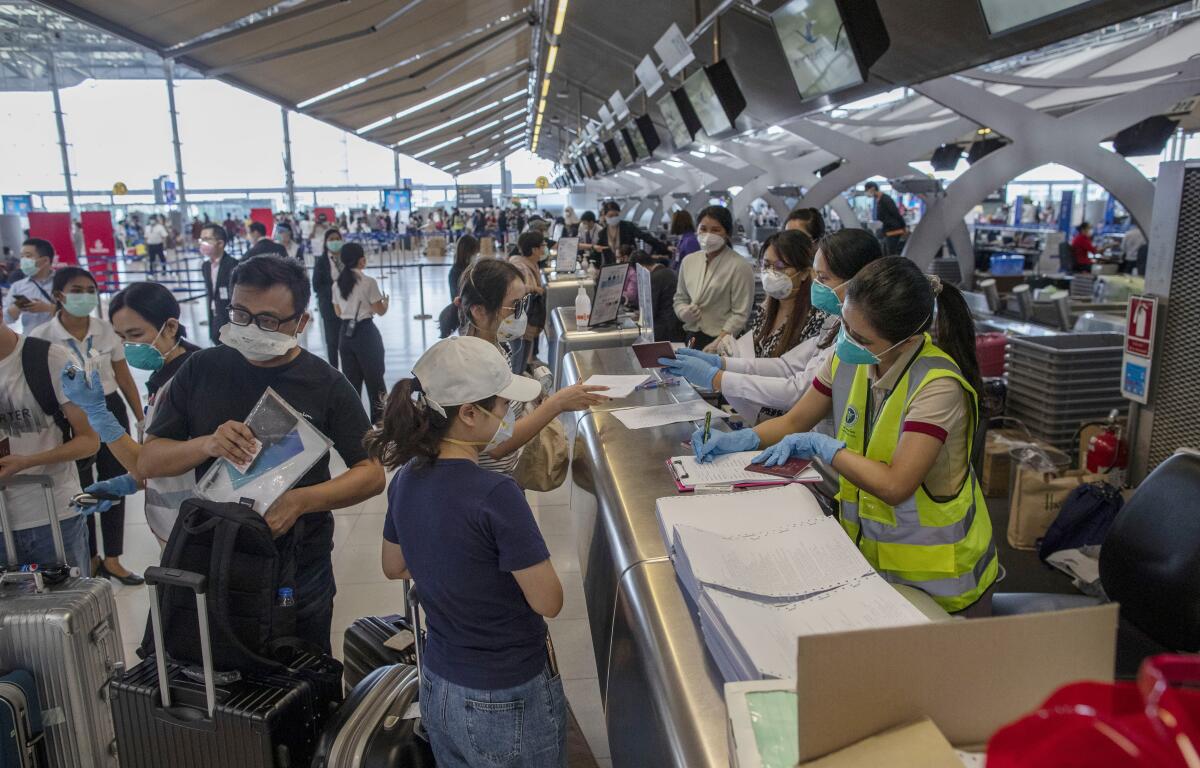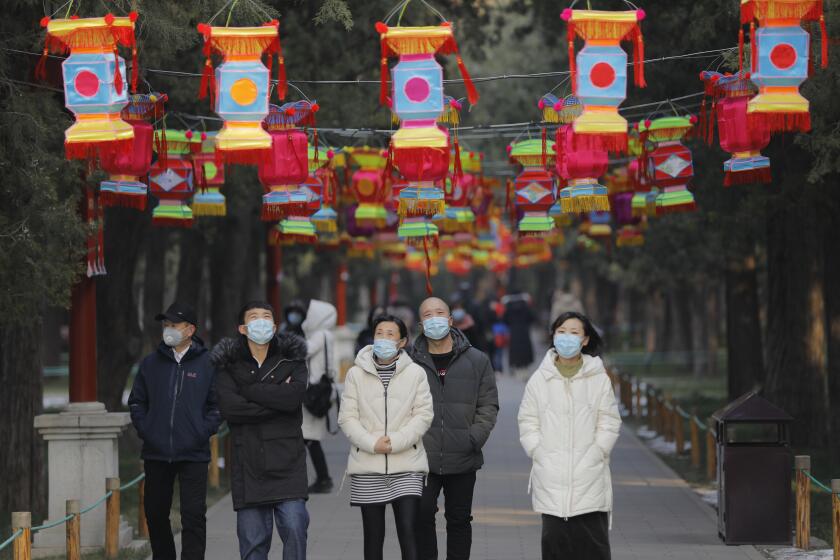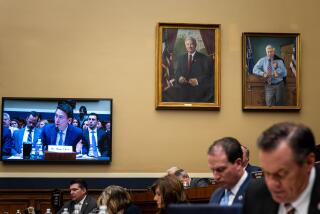As nations isolate themselves, coronavirus forces us to see we’re more connected than ever

- Share via
BANGKOK, Thailand — The Thai airline employee handed the passport back with a gloved hand and leaned over the counter, his voice muffled through a surgical mask. “I see you are American, but I have to ask: In the last two weeks, have you been in China?”
In the security line, removing his shoes, a South Asian man emitted a loud cough and hastily covered his mouth as fellow travelers cast suspicious glances. Beyond the checkpoint, a group of British tourists passed around a large bottle of hand sanitizer.
These are nervous days — not just at Bangkok’s Suvarnabhumi Airport, one of the world’s busiest hubs, but around the globe as a mysterious and deadly new virus hopscotches from continent to continent, leaving a trail of infections, quarantines and fear.
It seems a dark fable from long ago, yet it is very much a consequence of our times.
In its invisible journey from the central Chinese city of Wuhan to two dozen countries and counting, infecting more than 24,000 people, the novel coronavirus has been propelled by an air travel network that links people more efficiently than at any time in human history. Cases have been reported from Russia to Australia, from northern England to Southern California, most involving patients who traveled from China.

This is the world as we have shrunk it. Our money transactions zip through the ether, and our wants and fascinations move with the speed of a tweet. You can summon products from almost anywhere; once exotic ingredients on restaurant menus are flown in fresh. Families voyage across the oceans for weddings and summer vacations, and your neighbor’s recent business trip could have been to Seattle or Shenzhen.
It is a powerful conceit, bending time and space.
Now a single microbe — probably sprung from bats dwelling in far-off caves — has forced a reckoning and reminded us of the limits of that power. Just as Ebola rose from West Africa, and Zika from Brazil, a virus bearing a sinister name has once again broken loose from obscurity to shake our illusion of invulnerability.
“All these outbreaks underline the ways that the world is more interconnected than ever,” said Mark Honigsbaum, a British medical historian and author of “The Pandemic Century,” a 2019 book about public responses to outbreaks over the last 100 years.
“Nowhere is isolated anymore. Because of these connections, a virus can be anywhere on the globe within 72 hours.”
Health officials around the world are keeping a close watch on an outbreak of a virus in China. Here’s what you need to know about the coronavirus.
Disease outbreaks have long had a way of making the planet feel smaller. In medieval times, Mongol warriors and merchant ships carried bubonic plague out of Asia and into Europe, fueling the Black Death pandemic that killed tens of millions. At the dawn of the 20th century, a steamer carrying infected rats from China chugged into San Francisco harbor, marking the plague’s arrival on American shores.
Yet as the Wuhan coronavirus surfaced in December, the world had become so hyper-connected that it was starting to break apart.
The epidemic feeds nativist impulses and anti-globalization narratives at a time when many governments are turning inward, rejecting multilateral institutions and erecting barriers to trade and immigration. Right-wing populists are ascendant from Hungary to the Philippines. Last week, Britain formally exited the European Union and the Trump administration expanded its controversial “travel ban” by imposing visa restrictions against citizens of six more countries in Asia and Africa.
Even before the outbreak, China’s economy was reeling from a trade war led by President Trump that experts say has left both countries worse off. The administration’s campaign to cripple the Chinese telecommunications giant Huawei, which it dubs a global security threat, has raised the prospect that the U.S. and Chinese tech worlds could “decouple,” or split into separate spheres.
The coronavirus has made that split a reality — if temporarily.
Major American airlines suspended flights between the U.S. and the Chinese mainland. The Trump administration barred most foreign nationals who had recently been in China from entering the U.S. and sent Americans returning from Hubei, the province at the center of the outbreak, into quarantine for up to two weeks.
Other countries including Singapore, Australia and Israel soon followed suit with their own travel restrictions, even though the World Health Organization said such bans weren’t necessary. Starbucks, Apple and McDonald’s — cultural and commercial touchstones that have made us symbiotic — shut their Chinese stores.
But with U.S. and global economies more dependent on China than ever, these physical barriers did nothing to stop global stock markets from sliding.
“This knee-jerk response we’re seeing, to immediately put up the drawbridge, I think it’s very shortsighted,” Honigsbaum said.
“A microbe such as this coronavirus doesn’t obey travel restrictions. And you can’t just shut off and punish one area of the world without inflicting huge self-harm. We may see that in the coming days and weeks as the impact plays out on financial markets and trade.”
In the U.S., only 11 infections have been reported — six in California — with no fatalities. But drugstores and online retailers have seen a run on face masks, even though experts say they do little to prevent contagion.
Hoaxes and anti-Chinese messages have spread even in parts of Los Angeles, proving again that ethnic diversity does not inoculate a population from fear.
Social media has fed virus panic. But the world has become more interwoven. It should be harder to fear the Chinese when Chinese Americans are friends, family.
We’ve been here before. In 1908, the plague having traveled south from San Francisco, the Los Angeles Herald described Asian immigrant communities as filthy repositories of the virus and wrote that “anyone is exposed to the bite of an infected flea while passing near some Chinaman or Filipino who permits himself to carry about these tiny pests.”
Such racist stereotypes fueled support for a federal ban on Chinese immigrants, which stood for nearly six decades until its repeal in 1943.
Today’s health systems are much better at controlling the spread of disease. But xenophobia endures, fed by toxic political rhetoric and social media. A Chinese Foreign Ministry spokeswoman this week accused the U.S. of overreacting and spreading panic by evacuating its diplomats and restricting travel.
“We have a political and economic climate that has furthered antagonisms between” the U.S. and China, said William Deverell, a USC history professor. “Add to this the virus, and we don’t know where enmity might take us.
“It’s a scary time — and the fright may be every bit as much about what this will do to our perceptions of one another as what this disease may do to people and populations near and far.”
Tensions are higher in China’s immediate vicinity — in places such as Japan, Singapore and Thailand that took in huge numbers of Chinese travelers during January’s Lunar New Year, when Chinese health officials had not yet disclosed the scale of the virus’ spread.
China is ramping up censorship after the coronavirus outbreak. Police dressed in hazmat suits to ‘quarantine’ a man, then took him to a police station.
In Singapore, a shouting match broke out on a subway car last week when an ethnic Chinese man inadvertently sneezed on another passenger. When Thailand’s prime minister, Prayuth Chan-ocha, fell ill a day after touring coronavirus screening posts at Bangkok airport, the hashtag “RIPPrayuth” trended on Twitter, forcing the country’s health minister to deny publicly that the premier had the coronavirus.
“There is this edginess, that if someone coughs on a plane, there’s just that little moment where you think, ‘How close am I sitting to that person?’” said Brian P. Klein, a former U.S. diplomat in China and founder of Decision Analytics, a geopolitical risk advisory company.
Amid the uncertainty, however, are glimmers of what can be achieved when people remain connected.
Last week, doctors in Thailand said that they had treated a coronavirus patient with a cocktail of flu and anti-HIV drugs and that her condition had improved, offering hope that a cure for the virus could soon be developed.
And scientists in Australia became the first to re-create the virus in a cell culture, which could help international labs test trial vaccines and detect infections in patients who don’t show symptoms.
“When this kind of cooperation starts to emerge, it’s promising,” Klein said.
“This isn’t going to be the last crisis that the world is going to have to deal with together, and hopefully we’re learning each time how to cooperate better. When the old instincts kick in and countries decide to go it alone, you get a much worse problem than you would have had.”
More to Read
Sign up for Essential California
The most important California stories and recommendations in your inbox every morning.
You may occasionally receive promotional content from the Los Angeles Times.














